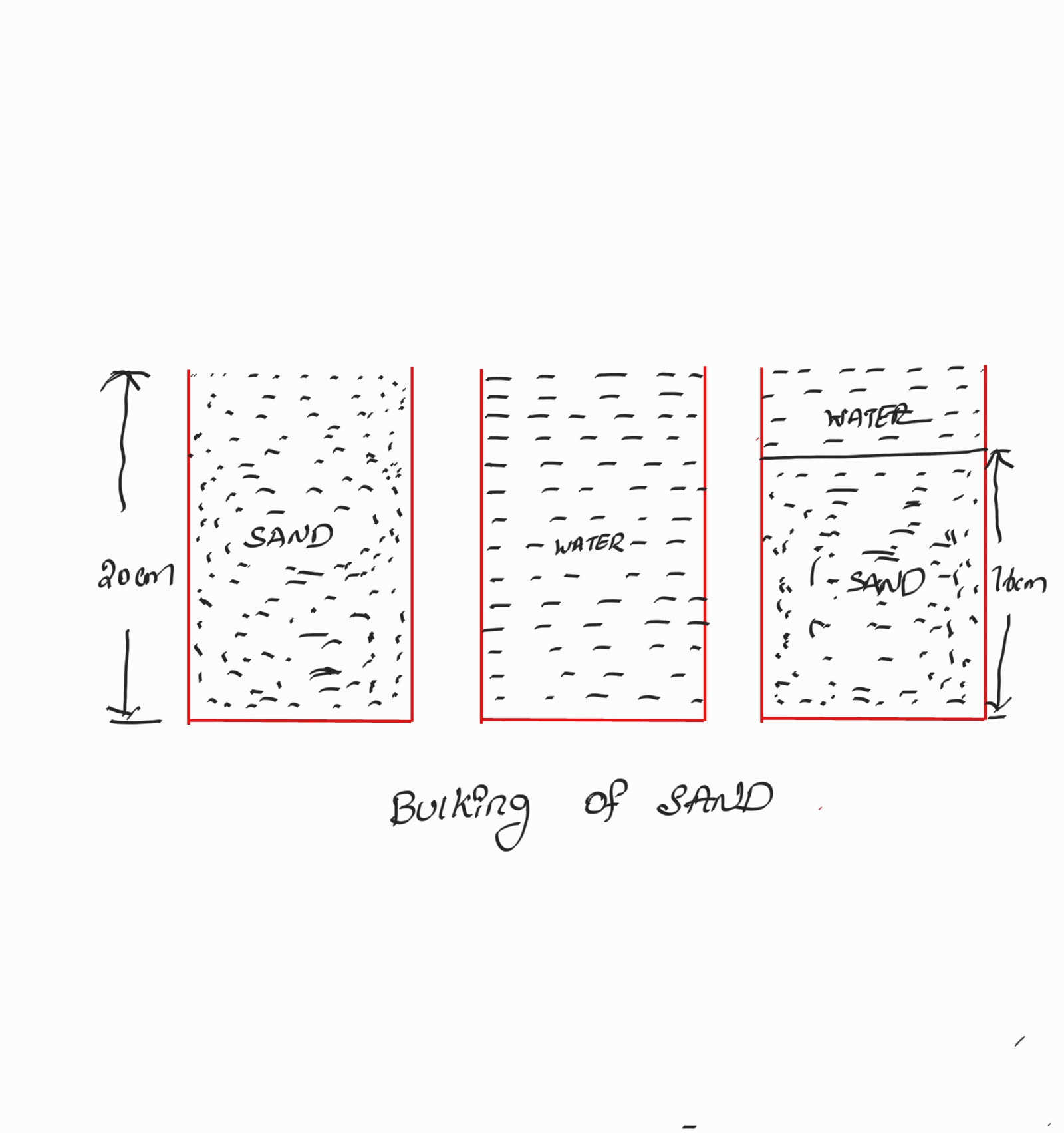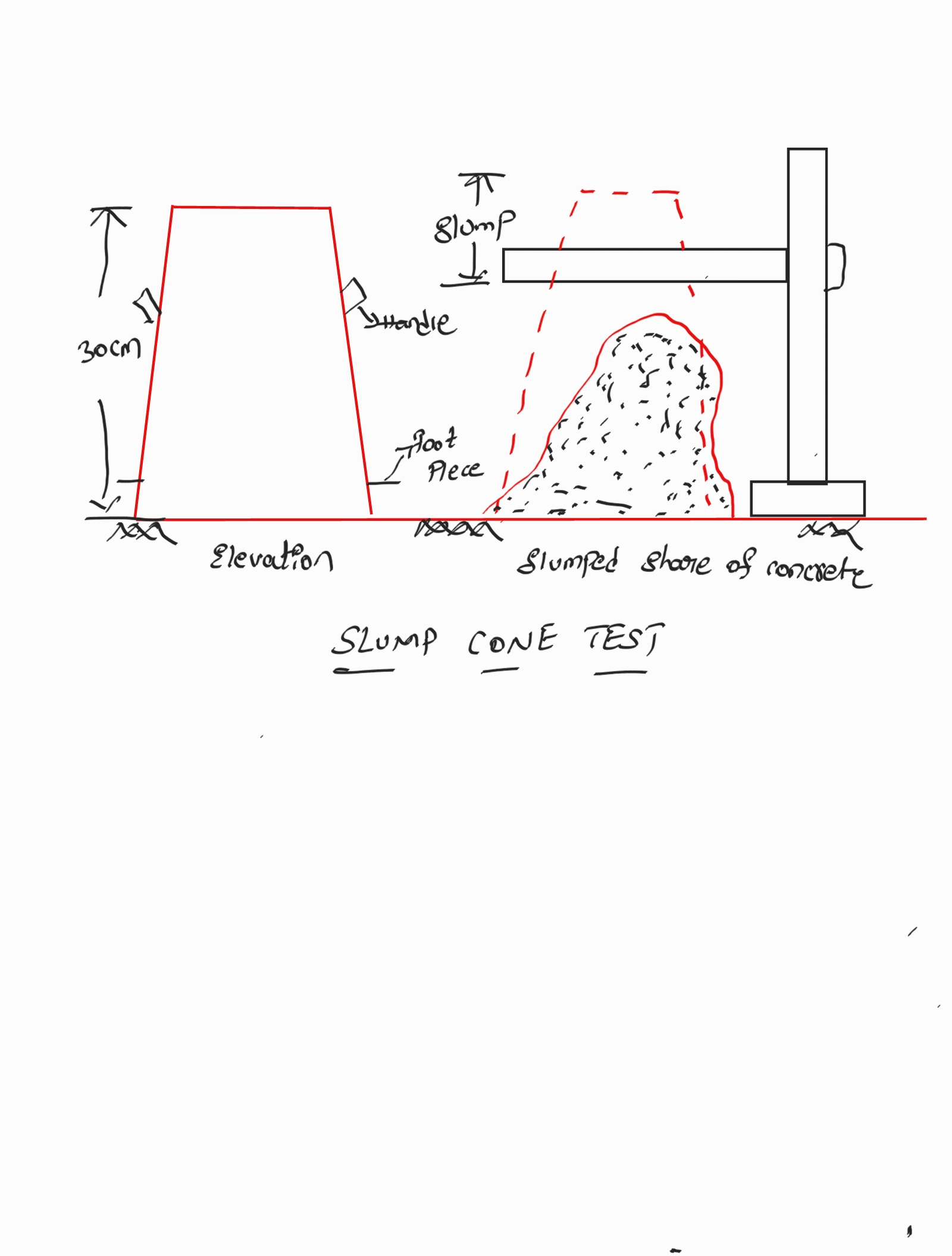Definition of Concrete
Process of mixing broken Granite metal or broken bricks with mortar in correct proportion is called concrete.This granite broken metal or broken brick is called coarse aggregate. Jelly denotes coarse aggregates only. It diggers from fine aggregate.The mortar may be cement sand or lime sand which is mixed with concrete when rod is re-inforced with con- crete then it is called reinforced concrete.
Constituents of Concrete and their Requirements
The materials that go to form concrete are:
1. Binding material, which is cement or lime.
2. Fine aggregate, which is sand or stone dust.
3. Coarse aggregate which are broken stone or broken brick.
Binding Material: Cement or lime binds the individual units of aggregate (fine and coarse) into a solid mass by virtue of its inherent properties of setting or -hardening in combination with water. It helps to fill tire voids and gives density to the concrete.
Fine Aggregate: Sand or stone dust serves to fill the voids in coarse aggregate and reduce the quantity of cement.
Coarse Aggregate: Broken stone or broken brick acts as main filler and forms the main bulk of concrete, around the surfaces of which the binding materials adhere in the form of a film.
Water: Water which is suitable for drinking is used for concrete mixing. Water serves as three purposes in concrete mixing.
1. It distributes the cement or lime so that every parti- cle of aggregate is coated by it and brought into inti- mate contact with each other.
2. It acts as a lubricant and gives workability to the mixture.
3. It chemically combines with the various compounds in cement or lime to form a binding medium for the pieces of aggregate. Water helps crystallisation and play an active part in contributing to the strength.of the concrete. The ratio of the amount of water to the amount of cement by weight is termed as water cement ratio.
Bulking of Sand
The presence of moisture in sand increases the vol- ume of sand. This is due to the fact that moisture causes film of water around sand particles which results in the increase of volume of sand. For a moisture content about 5 to 8 per cent, this increase of volume may be as much as 20 to 40 per cent, depending upon the grading of sand. The finer the material, the more will be the increase in volume for a given moisture content. This phenomena is known as the bulking of sand.

When moisture content is increased by adding more water, the sand particles pack near each other and the amount of bulking of sand is decreased. Thus the dry sand and the sand completely flooded with water have practi- cally the same volume.
A very simple test, may be carried out to decide the percentage of bulking of sand. Following procedure is adopted.
1. A container is taken and it is filled two-third with the sample of sand to be tested.
2. The height is measured, say it is (x) 20 cm.
3. The sand is taken out of container. Care should be taken to sec that there is no loss of sand during this transaction.
4. The container is filled with water
5. The sand is then slowly dropped in the container and it is thoroughly stirred by means of a rod.
6. The height of sand is measured say it is (y) 16 cm. Then, Bulking of sand = (x-y) /y×100
Grading of Aggregates:
Grading of aggregate means particle size distribu- tion of the aggregate. If all the particles of an aggregate were, of one size, more voids will be left in the aggregate mass. On the other hand an aggregate having particles of varying sizes will exhibit smaller voids. Principle of grad. ing is that the smaller size, particles fill up the voids left in larger size particles. By adopting proper percentages of various sized aggregate, composite aggregate mix can be developed which will be thoroughly graded. Properly graded aggregate produces dense concrete and needs smaller quantities of fine aggregate and cement. The grading of aggregate is expressed in terms of percentages by weight retained on a series of sieves 80mm, 40mm, 20mm, 10mm, 4.75mm 2.36 nm, 1.18mm, 600 micro, 300 mic and 150 mic are used for fine aggregate.
Gradation has an important effect on the workabili. ty and characteristics of fresh and hardened concrete. Gradation of aggregates is most important to produce workable concrete. A well graded concrete contains mini- mum voids to be filled by the cement paste. This means less quantity of cement and water which will further mean increased economy, higher strength, lower shrink- age and greater durability. Grading of fine aggregate has much effect on workability of concrete than grading of coarse aggregate. It is seen that very coarse sand are very fine sand is unsatisfactory for concrete making.
Water-Cement Ratio: Water reacts, with cement chemically and causes set- ting and hardening of concrete. It is found theoretically that water required is about 0-50 to 0-60 time the-weight of cement.
1. Minimum quantity of water should be used to rea- sonable degree of workability
2. Water Cement ratio for structures which are exposed to weather should be carefully decided. For instance, for structures which are regularly wetting and drying, water cement ratio by weight should be 0-45 and 0-55 for thin sections and mass concrete respectively. For structures which are continuosly under water, the water cement ratio by weight should be 0-55 and 0-65 for thin sections and mass concrete respectively.
3. A thumb rule for ordinary concrete given below assuming the materials are non-absorbent and dry may be adopted. Weight of water=28% of the weight of the cement+4% of the weight of total aggregates
Slump Test:
This test is used to determine the consistency of worka- bility of concrete and also the required amount of water. The slump test is now universally adopted both on the sites dur- ing the progress of the work and in the laboratory.

Preparation of Cement Concrete:
Materials of concrete should be mixed thoroughly so that there is uniform distribution of materials in the mass of concrete. Also the mixing should ensure that cement paste completely covers the surface of aggregate. Mixing can be done either by hand or by machine.
1. Hand Mixing: For hand mixing, the materials are stacked on a water tight platform, which may be either of wood, bricks or steel. The materials should be thoroughly mixed, at least three times, in dry condition before water is added. The prepared mix should be consumed in 30 minutes after adding water. Mixing by hand is allowed in case of small works or unimportant works. Where small quantity be adopted, it is advisable to use 10 percent more cement than specified.
2. Machine Mixing: Machine mixing is carried out by batch mixers or by continuous mixers. Batch type mixers are mostly adopted. Water should enter the mixer at the same time, or before the other materials are placed. The mixing time should be atieast one minute and preferably two minutes. The concrete discharged by the mixer should be consumed within 30 minutes. The mixer should be cleaned well after use. This type of mixing is more efficient.
Consolidation for compaction of Concrete
The object of consolidation of concrete is to eliminate air bubbles and thus to obtain maximum density to con- crete. An intimate contact between concrete and rein- forcement is ensured by proper consolidation. The process of consolidation of concrete can be done with the hand or with the help of vibrators.
1. Hand Consolidation: It is done with the help of steel timber screeds. Narrow and deep members are compacted with tamping rods. The slabs and floors are tamped with the help of screeds. Compaction should be done in layers of 300 mm for mass concrete and 150 mm for reinforced concrete.
2. Mechanical Compaction: Mechanical compaction of concrete in the formwork is carried out using mechanical devices called vibrators. The advantages of using vibrators are,
1. It is possible to make a harsh and stiff concrete mix.
2. It is possible to improve the quality of concrete.
3. It is possible to deposit concrete in small open- ings and in places where it will be difficult to deposit by hand methods.
Curing of Concrete:
Curing is the operation by which moist conditiona are maintained on finished concrete surface to promote continued hydration of cement. If proper curing is not done, that concrete will not acquire its full intended strength. Moreover, shrinkage racks will develop in the concrete. Curing also brings about improvement in dura- bility, impermeability, wear and weather resisting quali ties. There are several methods of curing. Adoption of spe cific method depends upon the nature of work and the cli matic conditions
Properties of Cement Concrete
1. It has a high compressive strength.
2. It is free from corrosion and there is no appreciable effect of atmospheric agents on it.
3. It hardens with age and the process of hardening continues for a long time after the concrete has attained sufficient strength.
4. It is proved to be more economical than steel
5. It binds rapidly with steel and as it is weak in ten- sion. Steel reinforcement is placed in cement con- crete at suitable places to lake up the tensile stress- es. This is temed as “Reinforced Cement Concrete or simply “R.C.C.”
6. Due to non absorption of water on the surface it gets the property of shinkage. If curing is not done shrinkage and crack occurs.
7. It has a tendency to be porous. This is due to the presence of voids which are formed during and after ita placing.
8. It forms a hard surface, capable of resisting abrasion.
Uses of Concrete:
Concrete is used for a great variety of purposes among which may be mentioned foundations for masonry works, especially in damp soil or under water, terrace roofs and floors, walls, arches, dama, bridges, piers, break- waters, lighthouses, retaining walls, sea walls etc. For most of these purposes it is superior to masonry in dura- bility, strength and economy.
Types of Concrete:
There are several types of cement concretes which can be developed to suitthe specific requirements. Such concrete are developed either by varying the proportions of usual cement concrete or by adding some additional constituents.
1. Cement concrete: Cement concrete is prepared with jelly. This concrete is used for the construction of Beam, Pillar, Roof, Floor and Dam. Those are used to make compression member 40 mmfelly, 20 mm jelly are also used in cement concrete, these are clas- sified as plain cement concrete and reinforced.
2. Lime concrete: This concrete is made by mixing lime mortar with 20 mm broken stone. These con- crete are used for foundation piers etc.
3. Light weight concrete: It is ordinary cement con- crete and that special light weight concrete can also be obtained by adding such agent which either develop gas or foam, during the process of mixing of concrete whichdevelops porous cellular structure of concrete
. 4. Air entrained concrete: This concrete is developed by either using air-entraining cement or other such agents.
5. No fines concrete: This cement concrete dose not have any fine aggregate. It is a mixture of cement. course aggregate and water only.
6. Vacuum concrete: Only about half of the water
added in concrete goes into chemical combination and the remaining water is used to make concrete workable. After laying, concrete, water which was making concreting workable is extracted by a special method known as vaccum method. This water left in this concrete is only that which is to go in chemical combination and hence resulting concrete becomes very strong.
7. Water proof concrete: This concrete is prepared by adding some water proofing or waterrepellant com- pound in the concrete. This concrete is used for ren- dering structures water proof.
8. Reinforced cement concrete: Ordinary cement concrete is very weak in tension, but very strong in compression. Steel rods may be embedded on the ten- sion side of the member. Such concrete in which steel rods are embedded is called reinforced cement con- crete, abbreviated as R.C.C.
9. Pre-Stressed Concrete: It is also reinforced cement but steel rods are pre-stressed before embed- ding in the concrete. These rods remain pre-stressed even after the concrete has fully set. Elements of this concrete when subjected to bending do not develop cracks. Pre-stressed concrete saves as much as 50% of concrete.
10. Cellular or aerated Concrete: This, concrete is made light by introducing air bubbles throughout the mass. It is useful for roofslab and precast units in partitions. It is made by adding aluminium powden to a rather wet mix of cement, sand, lime, and water. The mass begins to rise due to hydrogen bubbles evolved by the chemical action and there by cells are formed in the concrete.
11. Pre-cast Concrete: Pre-cast concrete is an ordinary cement concrete, but prepared not at the site of use, but in factory, where as cast-in-situ concrete is ordi. nary cement concrete which is prepared are the site of its actual use.
Safety Precaution to be taken while laying of Concrete:
Concrete, as it comes out of the mixer as it is ready for use on the form work. The type of equipment to be used for transport of concrete depends on the nature of work, height above ground level and distance between the points of preparation and placing of concrete. For ordinary buildingworks, human ladder is formed and concrete is conveyed in pans from hand to hand. For important works, various mechanical devices such, as dumpers, track mixers, buckets, chutes, belt conveyors, pumpa, hoist etc, may be used. The two important precautions necessary in transportation of concrete are as fellows:
The concrete should be transported in such a way that there is no segregation of the aggregates and no spilling of concrete. Underno circumstances water should be added to the concrete during its passage from the mixer, to, the form work.
The concrete should be placed and compacted before its setting starts Following precautions should be adopted while placing the concrete.
The form work of the surface which is to receive fresh concrete should be properly cleaned, prepared end well watered. It is desirable to deposit concrete as near as practicable to its final position.
While placing concrete, the position of form work end reinforcement should not be disturbed. To avoid segrega- tion, concrete should not be dropped from height more than one metre. Concrete should be laid continuously.
Thickness of concrete layer should not be more than 30-45cm in case of mass concrete and 15-30cm in case of R.C.C. works. Concrete should be thoroughly worked around the reinforcement and tapped in such a way that no honeycombed surface appears on the removal of the Form work. Concrete should be placed on the form work as moon as possible. But in no case, it should be placed afte 0 minutes of its preparation.
